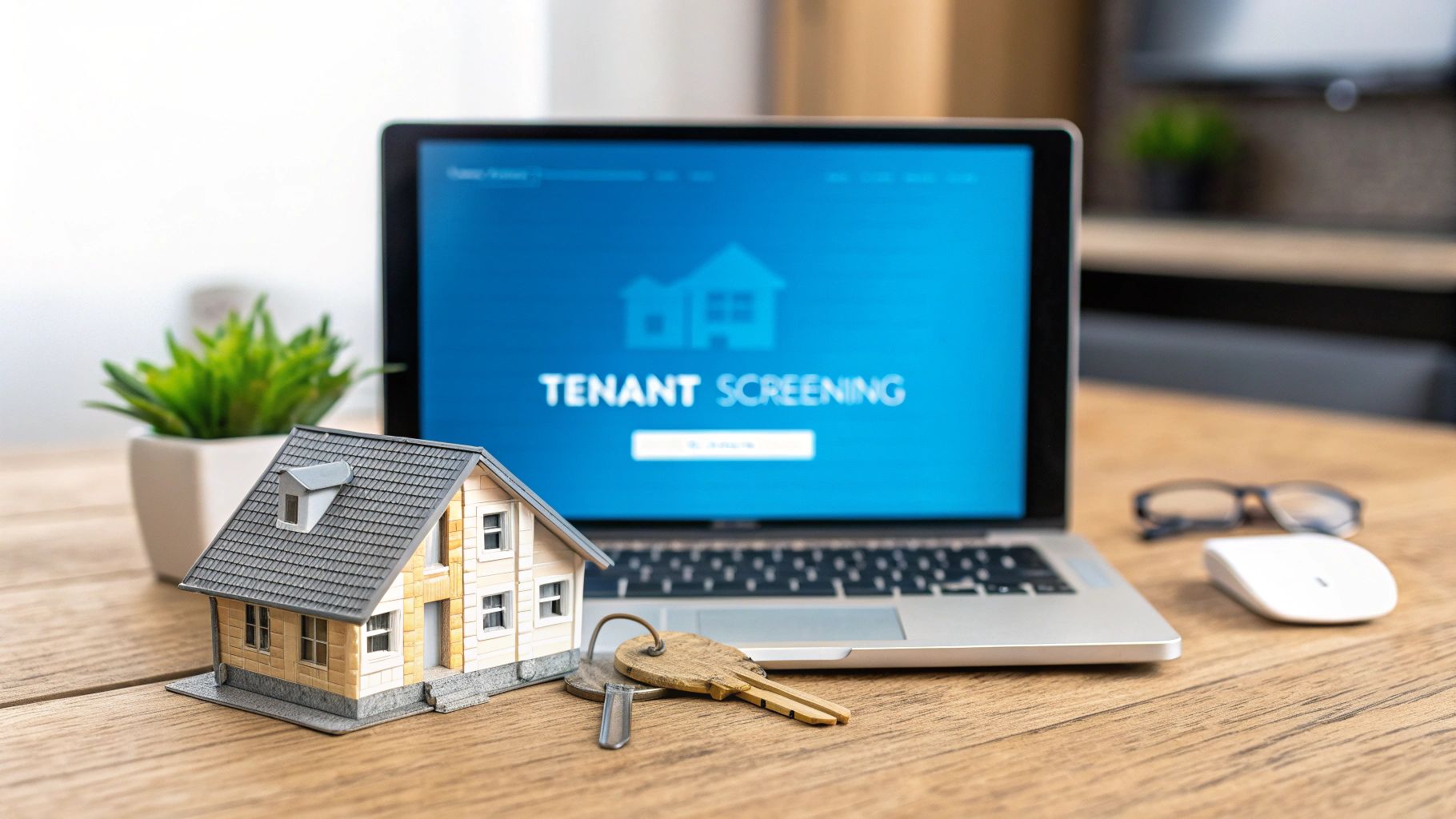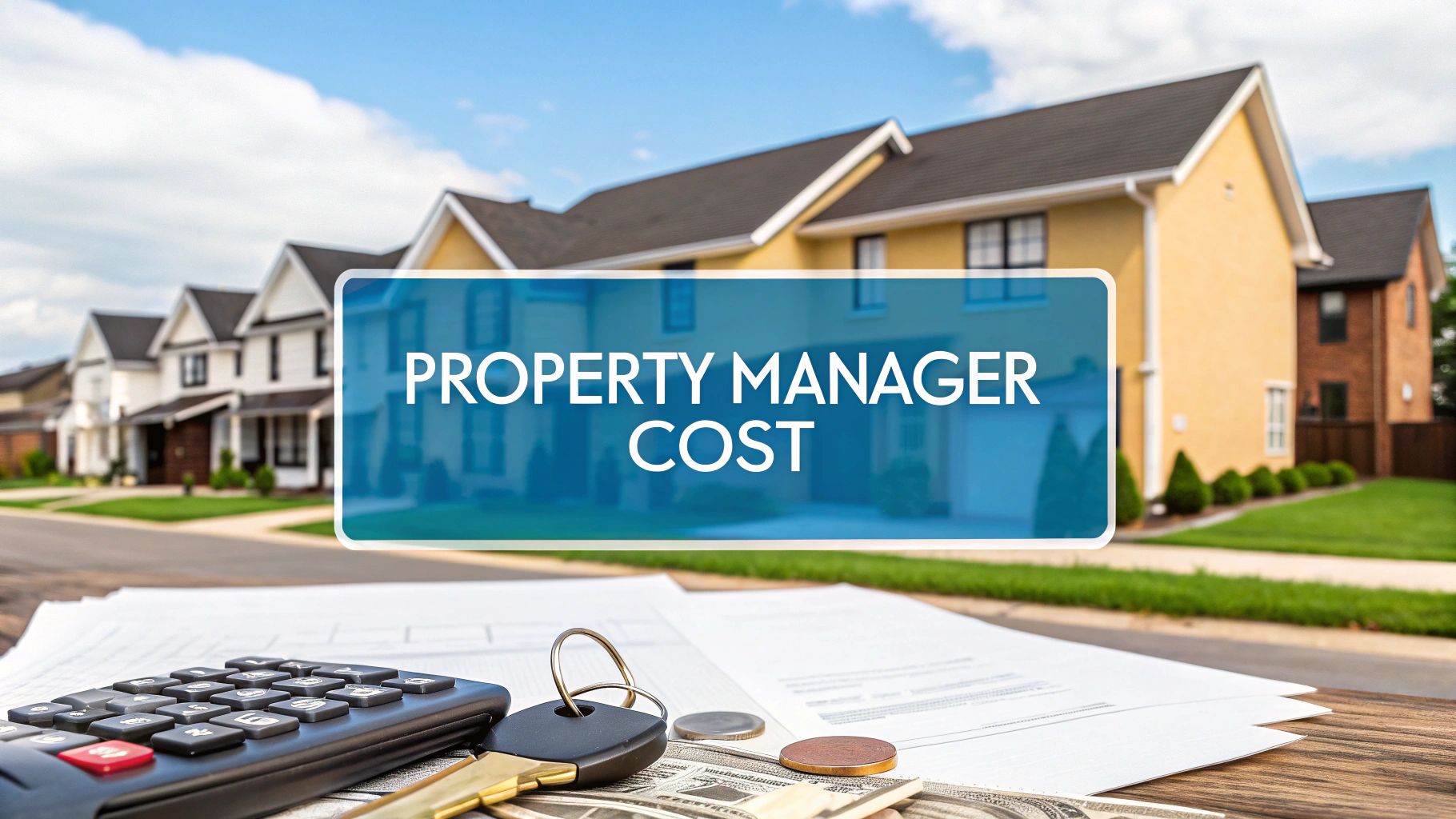For decades, the property management leasing model remained unchanged: an agent, a key, and a firm handshake. But for large-scale property management companies, this legacy model is a significant operational drag. It creates logistical nightmares across distributed portfolios, drives up the cost per door, and inflates Days on Market (DOM), directly eroding revenue.
The truth is, modern renter expectations for on-demand access have rendered the old way obsolete. For portfolios managing 100 to 10,000+ units, self-tour technology isn't a "nice-to-have"—it's a core component of a scalable, profitable leasing operation.
Why Self Tours Are Now Essential for Portfolio Growth
The relationship between renters and properties has fundamentally shifted. Today’s renters, primarily Millennials and Gen Z, operate in an on-demand economy. They can book a ride, order dinner, or stream a movie instantly—and they expect the same frictionless experience when touring their next home.
Forcing a qualified lead to wait 24-48 hours for an agent's availability creates a critical friction point. More often than not, it sends that high-intent lead straight to a competitor who offers instant, self-tour access.
For property managers juggling hundreds or thousands of units across multiple markets, this isn't just an inconvenience; it's a direct threat to the bottom line. Coordinating agent schedules across a dispersed portfolio is a logistical and financial drain that cripples leasing velocity.
The New Renter Expectation
Demand for single-family rentals (SFRs) has skyrocketed. Younger generations value the space and flexibility these homes offer without the long-term commitment of a mortgage. This large and growing demographic places a premium on convenience and autonomy.
If you’re not offering a self-tour option, you’re effectively excluding a massive segment of the market. You can explore more about this housing preference shift and its impact. This is no longer a fleeting trend; it’s a baseline requirement for any enterprise-level operator focused on portfolio growth.
By allowing prospects to tour properties on their schedule—whether it’s 7 AM on a Tuesday or 8 PM on a Friday—you eliminate the single biggest bottleneck in the leasing funnel: human availability. This speed-to-tour capability is the primary lever for reducing your Days on Market (DOM) and optimizing lead-to-tour conversion rates.
Breaking Down the Operational Inefficiencies
The traditional agent-led showing model is laden with variable costs that erode NOI, especially at scale. Consider the resources poured into every agent-led showing:
- Agent Commissions: A significant, recurring expense that negatively impacts your cost per lease.
- Travel Time & Expenses: Paying agents for non-productive drive time between scattered properties is a major operational drain.
- Scheduling Overhead: Your admin staff burn countless hours on low-value tasks, coordinating schedules between agents and dozens of leads.
When managing 1,000+ units, these inefficiencies snowball, leading directly to a higher cost-per-door and sluggish leasing velocity.
Self tour houses for rent flip this script entirely. They transform a manual, high-touch process into a scalable, automated system. By implementing self-tour technology, property managers can eliminate these operational drags. The result? You convert leads faster, slash revenue loss from vacancies, and position your portfolio for sustainable, scalable growth.
Analyzing the Financial Impact on Large Portfolios
For any large-scale property management company, every operational decision must be scrutinized through a financial lens. Implementing technology for self tour houses for rent isn't about appearing modern—it’s a strategic investment that directly impacts revenue, cost per door, and overall portfolio performance. The financial upside extends far beyond simple convenience.
The most immediate savings come from eliminating the direct costs of agent-led showings: leasing commissions, travel reimbursements, and the administrative burden of scheduling. But while these cost reductions are significant, the real game-changer is the revenue recovered by drastically slashing your Days on Market (DOM).
Calculating the True Cost of Vacancy
Every day a unit sits empty, it's a direct revenue leak. For enterprise portfolios, these daily losses accumulate into a staggering annual sum. The formula to calculate this impact is simple but powerful for demonstrating ROI to stakeholders.
Vacancy Cost Formula: (Monthly Rent / 30 Days) * DOM Reduction = Recovered Revenue Per Unit
Let's apply this to a real-world scenario. Imagine a portfolio of 1,000 units with an average rent of $2,200/month. If implementing self-tours reduces your average DOM by just seven days, the financial impact is substantial. That seven-day reduction recovers $513 per vacancy. Across the entire portfolio, assuming a standard turnover rate, this can translate to hundreds of thousands of dollars in recaptured annual revenue.
This infographic breaks down some of the key metrics that improve when you adopt a self-touring model.

As you can see, the benefits are interconnected. Self-tours deliver direct cost savings, improve operational efficiency, and enhance the renter experience simultaneously.
This financial efficiency is critical in the current market. Recent data shows that single-family rentals are a massive and growing part of the housing landscape. With demand remaining strong, optimizing operations to lease these properties faster is paramount. You can explore more about these rental market trends and what they mean for your portfolio strategy.
Unit Economics Comparison: Traditional vs. Self-Guided Tours
To fully grasp the ROI, a side-by-side comparison of unit economics is essential. The legacy agent-led model is burdened with variable costs that are difficult to control at scale. The self-tour model introduces predictable efficiencies that improve financial forecasting and performance.
Here’s a look at how the numbers shake out for a single vacant unit.
Unit Economics Comparison: Traditional vs. Self-Guided Tours Per Vacancy
The difference is stark. Self-touring technology moves your operation from a high-variable-cost, slow-moving process to a low-cost, high-velocity system. By embracing self tour houses for rent, property managers aren't just adding a feature. You're fundamentally re-engineering your financial operations to be more scalable and profitable in a competitive market.
A Scalable Framework for Rolling Out Self Tours
Implementing self-tours across a large, multi-market portfolio requires a structured approach. A haphazard rollout will create inconsistent renter experiences and operational chaos—the very inefficiencies you're trying to eliminate. The goal is to replace manual, one-off processes with a standardized, tech-driven system that scales seamlessly from 100 to 5,000+ units.
This implementation should be viewed as a phased process, allowing you to gather performance data, refine your operational playbook, and prove ROI before a full-scale deployment. A robust framework ensures every self tour house for rent in your portfolio delivers a consistent, high-quality experience that accelerates speed-to-lease.

Phase 1: The Pilot Program and Data Dive
Before a portfolio-wide deployment, run a controlled pilot program. Select a group of 25-50 units in one or two markets. This initial phase is focused on establishing baseline data and resolving operational kinks. Your primary objective is to measure the direct impact on your most critical leasing KPIs.
Track these metrics from day one:
- Days on Market (DOM): Compare the average DOM for pilot properties against your traditional agent-led model.
- Lead-to-Tour Conversion: What percentage of inquiries are converting into completed self-tours?
- Tour-to-Application Rate: Of the prospects who tour, how many submit an application?
- Prospect Feedback: Use automated post-tour surveys to gather qualitative data on the renter experience.
This pilot provides the hard data needed to build a compelling business case for a wider rollout and secure buy-in from key stakeholders.
Phase 2: Tech Integration and Standardization
With a successful pilot completed, the next step is to integrate the self-tour platform into your core operational tech stack. This is where true scalability is unlocked. The objective is to create a seamless flow of information that eliminates manual data entry and maintains your Property Management Software (PMS) as the single source of truth.
Critical Step: Establish a robust API connection between your self-showing platform and your PMS (e.g., AppFolio, Yardi) and CRM. This integration is non-negotiable for managing remote operations at scale, as it automates the syncing of property data, lead information, and showing schedules.
Next, standardize your hardware and installation processes. Create a clear, documented playbook for installing smart locks and lockboxes. This guide should specify preferred hardware models, provide step-by-step installation instructions, and include a simple quality control checklist to ensure consistency across all markets. Choosing the right technology is crucial; you can find expert advice on how to choose the best self-showing software to meet your portfolio's needs.
Phase 3: Marketing Automation and Full Rollout
The final phase is to fully embed the self-tour option into your marketing and leasing workflows. This requires training your team on the new, standardized process and updating all marketing collateral to prominently feature this convenient showing option.
Implement automated workflows that engage leads instantly:
- Instant SMS/Email Responses: Every inquiry from ILSs like Zillow and Apartments.com or your company website should trigger an immediate, automated reply containing a direct link for the prospect to schedule their self-tour.
- Updated Listing Language: Revise all property descriptions with strong calls-to-action like "Tour Today on Your Schedule!" or "Instant Self-Tour Access Available."
- Team Training: Equip your leasing team with scripts and protocols that position self-tours as the fastest and most convenient way to view a property.
By following this phased framework, you can systematically build a self-tour engine that slashes Days on Market, improves your cost-per-door, and delivers a modern leasing experience that scales with your portfolio.
Optimizing Marketing to Drive Self-Tour Leads

Implementing a self-tour system is only half the battle. The ROI is realized when you drive high-intent leads to use it. This requires your marketing to aggressively promote the speed and convenience of your self tour houses for rent. Shift from passive descriptions to active, compelling calls-to-action (CTAs) that promise renters what they value most: instant access and control.
Audit your listing copy on Zillow, Apartments.com, and your corporate website. "Contact us for a showing" is an outdated CTA that creates friction. Replace it with powerful, action-oriented language.
Proven High-Conversion CTAs:
- "Tour Instantly on Your Schedule"
- "Skip the Wait—Tour This Home Today"
- "Book Your Private Self-Tour Now"
These CTAs tap directly into the modern renter's desire for immediacy and have been shown to significantly boost lead-to-tour conversion rates.
Automating the Lead Nurturing Process
In leasing, speed-to-lead is everything. The moment a prospect inquires, an automated workflow must engage them to capitalize on their peak interest.
Set up instant SMS and email responders that fire the moment a lead is received. This first touchpoint must do more than just confirm receipt; it must include a direct link to schedule a self-tour. This simple automation removes friction and converts a passive inquiry into a scheduled showing in minutes, 24/7. Showdigs, for example, offers leasing automation that can build a system that converts leads around the clock.
By automating lead response with a direct self-tour link, property managers can increase lead-to-tour conversion by over 30%. This strategy meets prospects where they are—on their phones, ready to take action—and dramatically accelerates the leasing funnel.
Data-Driven Ad Spend and Optimization
Your self-tour platform is a goldmine of marketing attribution data. Use its analytics to identify which lead sources—Zillow, Facebook Marketplace, or your own PPC campaigns—are generating the most completed tours, not just clicks or inquiries. This insight allows you to allocate your marketing budget with surgical precision, doubling down on channels that deliver high-quality traffic.
As market conditions evolve, your strategy must adapt. A/B test different CTAs and listing headlines to continuously optimize performance. For fresh ideas and strategies, it helps to regularly check out blogs that offer up-to-date digital marketing insights. This data-first approach ensures every marketing dollar is actively working to reduce your days on market and maximize portfolio revenue.
Managing Security and Quality in a Remote Operation

For property managers with dispersed portfolios, the prospect of unaccompanied tours can raise valid concerns about security and property readiness. How do we secure assets, and how do we ensure each unit is presented in pristine, tour-ready condition? Managing self tour houses for rent without onsite staff demands a rock-solid operational plan.
Modern self-tour technology is engineered to address these challenges head-on. It's not about simply providing a key; it's a comprehensive system with layered security protocols that can offer greater accountability than traditional agent-led showings.
While some operators may ask, Are key lock boxes safe?, today's enterprise-grade systems have evolved far beyond a basic mechanical lockbox.
A Multi-Layered Security Framework
Leading self-touring platforms create a digital fortress around every showing. This system is designed to vet prospects and deter bad actors from the outset.
The process includes:
- Robust Identity Verification: Before scheduling a tour, a prospect must upload a valid government-issued ID. Many platforms now use facial recognition to match a live selfie with the ID, confirming their identity.
- Credit Card Authorization: Requiring a valid credit card for booking is a powerful deterrent. A small authorization hold creates a financial link to the prospect, discouraging misconduct.
- Time-Sensitive Access Codes: Prospects receive a unique, one-time-use code that is only active during their scheduled tour window. This prevents unauthorized re-entry and code sharing.
This multi-step verification process creates a complete digital audit trail. For every showing, you have a record of who was in the property, when they entered, and for how long. This provides a level of granular tracking and accountability often missing from traditional showings.
Maintaining Property Quality Without Onsite Staff
Security is one half of the equation; quality control is the other. A prospect encountering a dirty unit or a maintenance issue is a guaranteed lost lease. For remote operations, a system to ensure "tour readiness" is essential.
An effective framework for quality control includes:
- Automated Prospect Feedback: Immediately following a tour, an automated text or email should solicit feedback on the property's condition. This creates an instant feedback loop to flag issues like a missed cleaning or a burned-out lightbulb.
- On-Demand Agent Network: Leverage a network of on-demand field agents, like those available through Showdigs, for pre-tour property checks. These agents can ensure the unit is clean, secure, and presented in its best light before the first showing of the day.
- Automated Maintenance Alerts: Integrate your self-touring platform with your maintenance system. If a prospect reports an issue (e.g., a running toilet) in their post-tour survey, an alert can automatically trigger a work order, resolving the problem before it impacts the next tour.
This blend of technology and on-demand human support ensures every self tour house for rent in your portfolio is always show-ready, protecting your brand reputation and compressing your time-to-lease.
Common Questions About Implementing Self-Tours
Even for tech-forward property management companies, deploying a new operational model like self-touring raises critical questions about ROI, security, and system integration.
Here are the most common questions we hear from large portfolio managers evaluating this technology.
How Much Can We Realistically Reduce Days on Market?
While results vary by market and portfolio, property managers who fully adopt a self-touring model typically see a significant reduction in Days on Market (DOM), often between 5 to 10 days.
This reduction is driven by the complete elimination of scheduling delays. Instead of a lead waiting for an agent's availability, they can tour a property almost instantly. This immediate access is critical for capturing high-intent prospects and dramatically shortens the cycle from initial contact to a submitted application. Every day saved is pure revenue recovery.
What Is the Real ROI Factoring in Hardware and Software?
Property managers can typically expect to see a positive return on investment within the first 6-12 months. The ROI calculation is a straightforward comparison of your current cost-per-lease against the new, more efficient model.
- Costs: Include the monthly software subscription (SaaS) fees and the one-time capital expenditure for smart lock hardware.
- Gains: Gains are realized in two key areas. First, direct operational savings from eliminating leasing commissions and travel expenses. Second, and far more impactful, is the significant recovered rent from slashing vacancy days. For large portfolios, this recovered revenue almost always dwarfs the initial technology investment.
To get the full picture, it’s always a good idea to review the complete pros and cons of self-showings before making a final decision.
How Do Self-Tours Integrate with Our Existing PMS?
Leading platforms that enable self tour houses for rent are built for enterprise-scale operations and designed for seamless integration with major Property Management Software (PMS) like Yardi, AppFolio, and RealPage.
This integration is typically handled via an API (Application Programming Interface). The API acts as a bridge, automatically syncing critical data—such as property availability, pricing updates, and lead information—between the showing platform and your PMS. This eliminates double data entry and ensures your PMS remains the single source of truth for your entire portfolio.
What If a Prospect Damages a Property?
This is a primary concern for many operators, but in practice, it is an exceedingly rare event. Modern systems employ robust, multi-layered security protocols that act as a powerful deterrent.
Before gaining access, every prospect must pass through several security gates, including identity verification and credit card validation. This pre-screening process is highly effective at filtering out individuals with malicious intent. In the rare event of an incident, you have a complete digital audit trail documenting exactly who was in the unit and when, providing clear, actionable data for resolution.
Ready to slash your Days on Market and scale your leasing operations? Showdigs provides the most advanced leasing automation platform, combining smart technology with an on-demand agent network to convert leads faster. See how our system can transform your portfolio's performance at https://showdigs.com.







